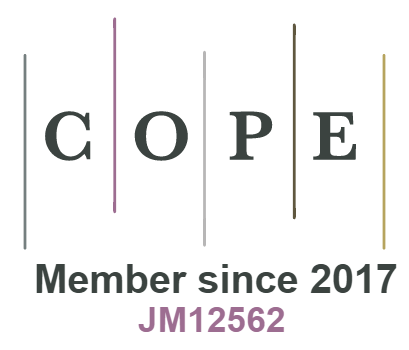Diagnosing Epidermal basal Squamous Cell Carcinoma in High-resolution, and Poorly Labeled Histopathological Imaging
DOI:
https://doi.org/10.18034/ei.v8i2.574Keywords:
Basal cell carcinomas (BCC), Machine learning, Convolutional neural networks (CNN), Histopathological imagingAbstract
The most appropriate method to uncover patterns from clinical records for each patient record is to create a bag with a variety of examples in the form of symptoms. The goal of medical diagnosis is to find useful ones first and then map them to one or more diseases. Patients are often represented as vectors in some aspect. Pathologists and dermatopathologists diagnose basal cell carcinomas (BCC), one of the most frequent cutaneous cancers in humans, on a regular basis. Improving histological diagnosis by producing diagnosis ideas, i.e. computer-assisted diagnoses, is a hotly debated research topic aimed at improving safety, quality, and efficiency. Due to their improved performance, machine learning approaches are rapidly being used. Typical images obtained by scanning histological sections, on the other hand, frequently have a resolution insufficient for today's state-of-the-art neural networks. Furthermore, weak labels hamper network training because just a small portion of the image signals the disease class, while the majority of the image is strikingly comparable to the non-disease class. The goal of this work is to see if attention-based deep learning models can detect basal cell carcinomas in histological sections and overcome the ultra-high resolution and poor labeling of full slide images. With an AUC of 0.99, we show that attention-based models can achieve nearly flawless classification performance.
Downloads
References
Abedin, M. M. M., Ahmed, A. A. A., and Neogy, T. K. (2012). Mechanism of Accountability and Auditing: Public Sector Scenarios of Bangladesh. Journal of Business Studies, 4, 131-148.
Ahmed, A. A. A. & Dey, M. M. (2009a. Timeliness attributes and the extent of accounting disclosure: a study of banking companies in Bangladesh. Osmania Journal of International Business Studies, 4(1).
Ahmed, A. A. A. (2009). The Effect of Timeliness Regulation of Corporate Financial Reporting: Evidence from Banking Sector of Bangladesh. Accounting and Management Information Systems, 8(2), 216 - 235. http://online-cig.ase.ro/jcig/art/8_2_4.pdf
Ahmed, A. A. A. and Neogy, T. K. (2009). Merger & Acquisitions (M&A) Goodwill Accounting: Principles and Practice. The Bangladesh Accountant, 65, 75-91.
Ahmed, A. A. A., & Dey, M. M. (2009b). Corporate Attribute and the Extent of Disclosure: A Study of Banking Companies in Bangladesh. Proceedings of the 5th International Management Accounting Conference (IMAC), OCT 19-21, 2009, UKM, Kuala Lumpur, MALAYSIA, Pages: 531-553. https://publons.com/publon/11427801/
Ahmed, A. A. A., Khan, W., & Hossain, M. S. (2011). Reporting Practice of Accounting Disclosure on Changes in Listed Companies of Bangladesh. ASA University Review, 5(1), 83-96. https://www.researchgate.net/publication/336664901
Albarqouni, S., Baur, C., Achilles, F., Belagiannis, V., Demirci, S., and Navab, N. (2016). Aggnet: deep learning from crowds for mitosis detection in breast cancer histology images. IEEE transactions on medical imaging, 35(5), 1313–1321. DOI: https://doi.org/10.1109/TMI.2016.2528120
Amin, R., & Manavalan, M. (2017). Modeling Long Short-Term Memory in Quantum Optical Experiments. International Journal of Reciprocal Symmetry and Physical Sciences, 4, 6–13. Retrieved from https://upright.pub/index.php/ijrsps/article/view/48
Andrews, S., Tsochantaridis, I. and Hofmann, T. (2003). Support vector machines for multiple-instance learning. In Advances in neural information processing systems, 577-584.
Azad, M. R., Khan, W., & Ahmed, A. A. A. (2011). HR Practices in Banking Sector on Perceived Employee Performance: A Case of Bangladesh. Eastern University Journal, 3(3), 30–39. https://doi.org/10.5281/zenodo.4043334
Begum, R., Ahmed, A. A. A., & Neogy. T. K. (2012). Management Decisions and Univariate Analysis: Effects on Corporate Governance in Bangladesh. Journal of Business Studies, 3, 87-115.
Bynagari, N. B. (2018). On the ChEMBL Platform, a Large-scale Evaluation of Machine Learning Algorithms for Drug Target Prediction. Asian Journal of Applied Science and Engineering, 7, 53–64. Retrieved from https://upright.pub/index.php/ajase/article/view/31
Bynagari, N. B. (2019). GANs Trained by a Two Time-Scale Update Rule Converge to a Local Nash Equilibrium. Asian Journal of Applied Science and Engineering, 8, 25–34. Retrieved from https://upright.pub/index.php/ajase/article/view/32
Bynagari, N. B., & Amin, R. (2019). Information Acquisition Driven by Reinforcement in Non-Deterministic Environments. American Journal of Trade and Policy, 6(3), 107-112. https://doi.org/10.18034/ajtp.v6i3.569 DOI: https://doi.org/10.18034/ajtp.v6i3.569
Bynagari, N. B., & Fadziso, T. (2018). Theoretical Approaches of Machine Learning to Schizophrenia. Engineering International, 6(2), 155-168. https://doi.org/10.18034/ei.v6i2.568 DOI: https://doi.org/10.18034/ei.v6i2.568
Chinem, V. P. and Miot, H. A. (2011). Epidemiology of basal cell carcinoma. Anais Brasileiros de Dermatologia, 86(2), 292–305. DOI: https://doi.org/10.1590/S0365-05962011000200013
Dietterich, T. G., Lathrop, R. H. and Lozano-Pérez, T. (1997). Solving the multiple instance problem with axis-parallel rectangles. Artificial intelligence, 89(1-2), 31-71. DOI: https://doi.org/10.1016/S0004-3702(96)00034-3
Donepudi, P. K. (2014a). Technology Growth in Shipping Industry: An Overview. American Journal of Trade and Policy, 1(3), 137-142. https://doi.org/10.18034/ajtp.v1i3.503 DOI: https://doi.org/10.18034/ajtp.v1i3.503
Donepudi, P. K. (2014b). Voice Search Technology: An Overview. Engineering International, 2(2), 91-102. https://doi.org/10.18034/ei.v2i2.502 DOI: https://doi.org/10.18034/ei.v2i2.502
Donepudi, P. K. (2015). Crossing Point of Artificial Intelligence in Cybersecurity. American Journal of Trade and Policy, 2(3), 121-128. https://doi.org/10.18034/ajtp.v2i3.493 DOI: https://doi.org/10.18034/ajtp.v2i3.493
Donepudi, P. K. (2016). Influence of Cloud Computing in Business: Are They Robust?. Asian Journal of Applied Science and Engineering, 5(3), 193-196. Retrieved from https://journals.abc.us.org/index.php/ajase/article/view/1181
Esteva, A., Kuprel, B., Novoa, R. A., Ko, J., Swetter, S. M., Blau, H. M., and Thrun, S. (2017). Dermatologist-level classification of skin cancer with deep neural networks. Nature, 542(7639), 115– 118. DOI: https://doi.org/10.1038/nature21056
Fadziso, T., & Manavalan, M. (2017). Identical by Descent (IBD): Investigation of the Genetic Ties between Africans, Denisovans, and Neandertals. Asian Journal of Humanity, Art and Literature, 4(2), 157-170. https://doi.org/10.18034/ajhal.v4i2.582 DOI: https://doi.org/10.18034/ajhal.v4i2.582
Foulds, J. and Frank, E., (2010). A review of multi-instance learning assumptions. The Knowledge Engineering Review, 25(1), 1-25. DOI: https://doi.org/10.1017/S026988890999035X
Griffin, J. and Treanor, D. (2017). Digital pathology in clinical use: Where are we now and what is holding us back? Histopathology, 70(1), 134–145. DOI: https://doi.org/10.1111/his.12993
Ilse, M., Tomczak, J. M., and Welling, M. (2018). Attention-based deep multiple instance learning. arXiv preprint arXiv:1802.04712
Janowczyk, A. and Madabhushi, A. (2016). Deep learning for digital pathology image analysis: A comprehensive tutorial with selected use cases. Journal of pathology informatics, 7. DOI: https://doi.org/10.4103/2153-3539.186902
Komura, D. and Ishikawa, S. (2018). Machine learning methods for histopathological image analysis. Computational and structural biotechnology journal, 16, 34–42. DOI: https://doi.org/10.1016/j.csbj.2018.01.001
Krizhevsky, A., Sutskever, I., and Hinton, G. E. (2012). Imagenet classification with deep convolutional neural networks. In Advances in neural information processing systems, 1097–1105.
LeCun, Y., Bottou, L., Bengio, Y., Haffner, P. (1998). Gradient-based learning applied to document recognition. Proceedings of the IEEE, 86(11), 2278–2324. DOI: https://doi.org/10.1109/5.726791
Lin, Z., Feng, M., Santos, C. N. D., Yu, M., Xiang, B., Zhou, B. and Bengio, Y. (2017). A structured self-attentive sentence embedding. arXiv preprint arXiv:1703.03130.
Manavalan, M. (2014). Fast Model-based Protein Homology Discovery without Alignment. Asia Pacific Journal of Energy and Environment, 1(2), 169-184. https://doi.org/10.18034/apjee.v1i2.580 DOI: https://doi.org/10.18034/apjee.v1i2.580
Manavalan, M. (2018). Do Internals of Neural Networks Make Sense in the Context of Hydrology?. Asian Journal of Applied Science and Engineering, 7, 75–84. Retrieved from https://upright.pub/index.php/ajase/article/view/41
Manavalan, M. (2019). P-SVM Gene Selection for Automated Microarray Categorization. International Journal of Reciprocal Symmetry and Physical Sciences, 6, 1–7. Retrieved from https://upright.pub/index.php/ijrsps/article/view/43
Manavalan, M. (2019). Using Fuzzy Equivalence Relations to Model Position Specificity in Sequence Kernels. Asian Journal of Applied Science and Engineering, 8, 51–64. Retrieved from https://upright.pub/index.php/ajase/article/view/42
Momeni, A., Thibault, M., and Gevaert, O. (2018). Deep recurrent attention models for histopathological image analysis. BioRxiv, page 438341. DOI: https://doi.org/10.1101/438341
Neogy, T. K. and Ahmed, A. A. A. (2015). The Extent of Disclosure of Different Components of Disclosure Index: A Study on Commercial Banks in Bangladesh. Global Disclosure of Economics and Business, 4(2), 100-110. https://doi.org/10.18034/gdeb.v4i2.139 DOI: https://doi.org/10.18034/gdeb.v4i2.139
Qi, C. R., Su, H., Mo, K. and Guibas, L. J. (2017). Pointnet: Deep learning on point sets for 3d classification and segmentation. Proc. Computer Vision and Pattern Recognition (CVPR), IEEE, 1(2), p.4.
Ramon, J. and De Raedt, L. (2000). Multi instance neural networks. In Proceedings of the ICML-2000 workshop on attribute-value and relational learning, 53-60.
Siddique, M. N. & Ahmed, A. A. A. (2015). Congruence of Competitive Advantage and Transfer Pricing: A Study on Selected MNCs Operating in Bangladesh. Asian Accounting & Auditing Advancement, 5(2), 119-126. https://www.researchgate.net/publication/354712086
Simonyan, K. and Zisserman, A. (2014). Very deep convolutional networks for large-scale image recognition. arXiv preprint arXiv:1409.1556
Sun, X., Tan, J., Tang, L., Guo, J. J. and Li, X. (2018). Real world evidence: experience and lessons from China. Bmj, 360, p.j5262.
Sun, X., Tan, J., Tang, L., Guo, J. J. and Li, X. (2018). Real world evidence: experience and lessons from China. Bmj, 360, p.j5262. DOI: https://doi.org/10.1136/bmj.j5262
Sundararajan, M., Taly, A., and Yan, Q. (2017). Axiomatic Attribution for Deep Networks. In ICML’17 Proceedings of the 34th International Conference on MAchine Learing - Volume 70, 3319–3328.
Vaswani, A., Shazeer, N., Parmar, N., Uszkoreit, J., Jones, L., Gomez, A. N., Kaiser, Ł. and Polosukhin, I. (2017). Attention is all you need. In Advances in Neural Information Processing Systems, 5998-6008.
Wang, X., Yan, Y., Tang, P., Bai, X. and Liu, W. (2018). Revisiting multiple instance neural networks. Pattern Recognition, 74, 15-24. DOI: https://doi.org/10.1016/j.patcog.2017.08.026
Wang, Z., Poon, J., Sun, S. and Poon, S., 2018. CNN based Multi-Instance Multi-Task Learning for Syndrome Differentiation of Diabetic Patients. arXiv preprint arXiv:1812.07764. DOI: https://doi.org/10.1109/BIBM.2018.8621344
Wei, X. S., Wu, J. and Zhou, Z. H. (2014). Scalable multiinstance learning. In Data Mining (ICDM), 2014 IEEE International Conference, 1037-1042. DOI: https://doi.org/10.1109/ICDM.2014.16
Xu, K., Ba, J., Kiros, R., Cho, K., Courville, A., Salakhudinov, R., Zemel, R. and Bengio, Y. (2015). Show, attend and tell: Neural image caption generation with visual attention. In International conference on machine learning, 2048-2057.
Yan, Y., Wang, X., Guo, X., Fang, J., Liu, W. and Huang, J. (2018). Deep Multi-instance Learning with Dynamic Pooling. In Asian Conference on Machine Learning, 662-677.
Zhang, M. L. and Zhou, Z. H. (2004). Improve multi-instance neural networks through feature selection. Neural Processing Letters, 19(1), 1-10. DOI: https://doi.org/10.1023/B:NEPL.0000016836.03614.9f
Zhang, Q. and Goldman, S. A. (2002). EM-DD: An improved multipleinstance learning technique. In Advances in neural information processing systems, 1073-1080.
Zhao, Y., He, L., Xie, Q., Li, G., Liu, B., Wang, J., Zhang, X., Zhang, X., Luo, L., Li, K. and Jing, X. (2015). A novel classification method for syndrome differentiation of patients with AIDS. Evidence-Based Complementary and Alternative Medicine. DOI: https://doi.org/10.1155/2015/936290
Zhou, Z. H. (2017). A brief introduction to weakly supervised learning. National Science Review, 5(1), 44-53. DOI: https://doi.org/10.1093/nsr/nwx106
Zhou, Z. H., Sun, Y. Y. and Li, Y. F. (2009). Multi-instance learning by treating instances as non-iid samples. In Proceedings of the 26th annual international conference on machine learning (pp. 1249-1256). DOI: https://doi.org/10.1145/1553374.1553534
--0--
Downloads
Published
Issue
Section
License
Engineering International is an Open Access journal. Authors who publish with this journal agree to the following terms:
- Authors retain copyright and grant the journal the right of first publication with the work simultaneously licensed under a CC BY-NC 4.0 International License that allows others to share the work with an acknowledgment of the work's authorship and initial publication in this journal.
- Authors are able to enter into separate, additional contractual arrangements for the non-exclusive distribution of the journal's published version of their work (e.g., post it to an institutional repository or publish it in a book), with an acknowledgment of its initial publication in this journal. We require authors to inform us of any instances of re-publication.









